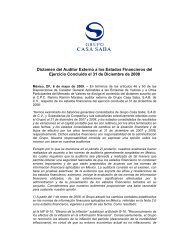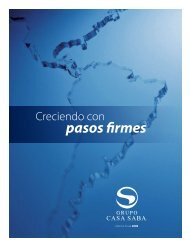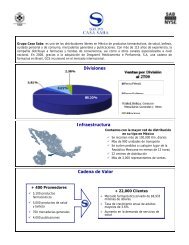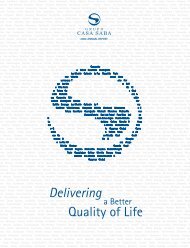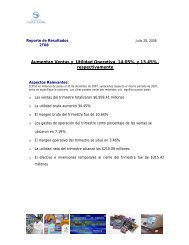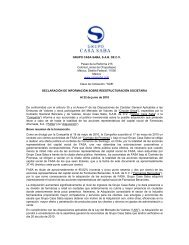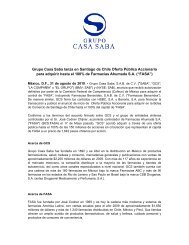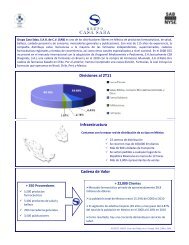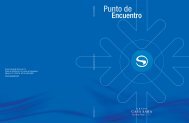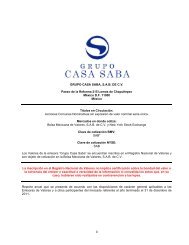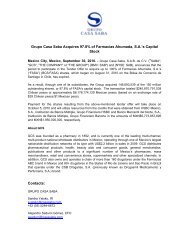FORM 20-F Grupo Casa Saba, S.A.B. de C.V.
FORM 20-F Grupo Casa Saba, S.A.B. de C.V.
FORM 20-F Grupo Casa Saba, S.A.B. de C.V.
Create successful ePaper yourself
Turn your PDF publications into a flip-book with our unique Google optimized e-Paper software.
Table of Contents<br />
At December 31, <strong>20</strong>11, <strong>20</strong>10 and <strong>20</strong>09, the fun<strong>de</strong>d status (benefits’ obligation less fair value of plan assets) of the <strong>de</strong>fined benefit pension and other postretirement plans that consi<strong>de</strong>rs<br />
the unrecognized net transition obligation, negative plan amendments and unrecognized net loss (gain) amounted to Ps.121,417, Ps. 112,954 and Ps. 66,115, respectively, which was<br />
recor<strong>de</strong>d in other comprehensive income, net of income tax. Therefore a reconciliation line item is shown in Note 23).<br />
g) Goodwill<br />
Goodwill recognized un<strong>de</strong>r Mexican FRS has been adjusted for U.S. GAAP purposes because beginning January 1, <strong>20</strong>02, goodwill is not amortized un<strong>de</strong>r U.S. GAAP, while un<strong>de</strong>r<br />
Mexican FRS goodwill was amortized until December 31, <strong>20</strong>04. Therefore a reconciliation line item is shown in Note 23).<br />
In addition, un<strong>de</strong>r U.S. GAAP, the Group assesses goodwill and in<strong>de</strong>finite-lived intangible assets for impairment annually unless events occur that require more frequent<br />
reviews. Discounted cash flows analyses consi<strong>de</strong>ring the use of market consi<strong>de</strong>rations are applied to assess the possible impairment of goodwill and in<strong>de</strong>finite life intangible assets. If<br />
an assessment indicates impairment, the impaired asset is written down to its fair value based on the best information available. Consi<strong>de</strong>rable judgment is necessary to estimate<br />
discounted future cash flows. Assumptions used for cash flows are consistent with internal forecasts and industry practices. In addition, the growth and discount rates in <strong>de</strong>termining<br />
its projected future cash flows are used by the Group. All these provisions are virtually i<strong>de</strong>ntical to Mexican GAAP and U.S. GAAP. Differences in other factors explained below led to<br />
different impairment loss or impairment testing results between Mexican FRS and U.S. GAAP.<br />
Un<strong>de</strong>r U.S. GAAP, the first step of the goodwill impairment test, used to i<strong>de</strong>ntify potential impairment, compares the fair value of a reporting unit with its carrying amount, including<br />
goodwill. If the carrying amount of the reporting unit exceeds its fair value, the “second step” of the goodwill impairment test discussed below is applied by the Group to measure the<br />
amount of impairment loss, if any. If the fair value of a reporting unit exceeds its carrying amount, goodwill of the reporting unit is consi<strong>de</strong>red not impaired, thus the second step of the<br />
impairment test is unnecessary.<br />
The second step consists of comparing the “implied fair value” of reporting unit goodwill with the carrying amount of that goodwill. If the carrying amount exceeds the implied fair<br />
value, an impairment loss is recognized in an amount equal to that excess. The implied fair value is <strong>de</strong>termined by allocating the fair value of a reporting unit to all of the assets and<br />
liabilities of that unit (including any unrecognized intangible assets) as if the reporting unit had been acquired in a business combination and the fair value of the reporting unit was the<br />
price paid to acquire the reporting unit. The excess of the fair value of a reporting unit over the amounts assigned to its assets and liabilities is the implied fair value of goodwill. That<br />
allocation process is performed only for purposes of testing goodwill for impairment.<br />
The situation referred to above, in addition to differences in the <strong>de</strong>termination of the “value in use” by applying the “perpetuity value” (Note 3 n) un<strong>de</strong>r Mexican FRS as compared to<br />
U.S. GAAP, as well as differences in the reporting units’ carrying amounts between Mexican FRS and U.S. GAAP, generate, when applicable, different amounts of impairment losses. In<br />
addition, un<strong>de</strong>r U.S. GAAP subsequent reversal of a previously recognized goodwill impairment loss is prohibited once the measurement of that loss is completed, while Mexican GAAP<br />
allows the reversal of the recognition of impairment un<strong>de</strong>r certain circumstances. Moreover, impairment loss un<strong>de</strong>r U.S. GAAP is inclu<strong>de</strong>d in the <strong>de</strong>termination of operating<br />
income. Un<strong>de</strong>r Mexican FRS, this item is part of “Other expenses, net”.<br />
F-59



